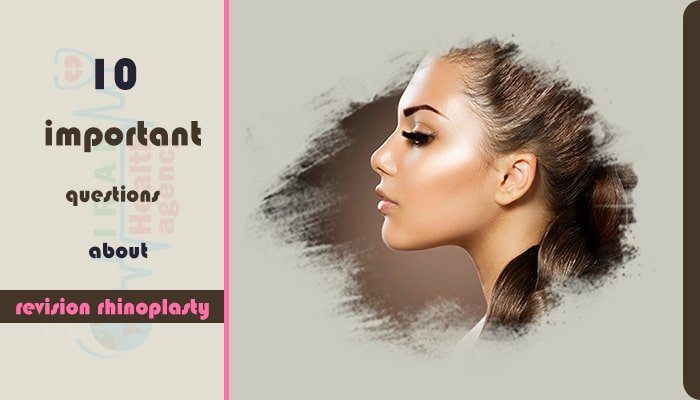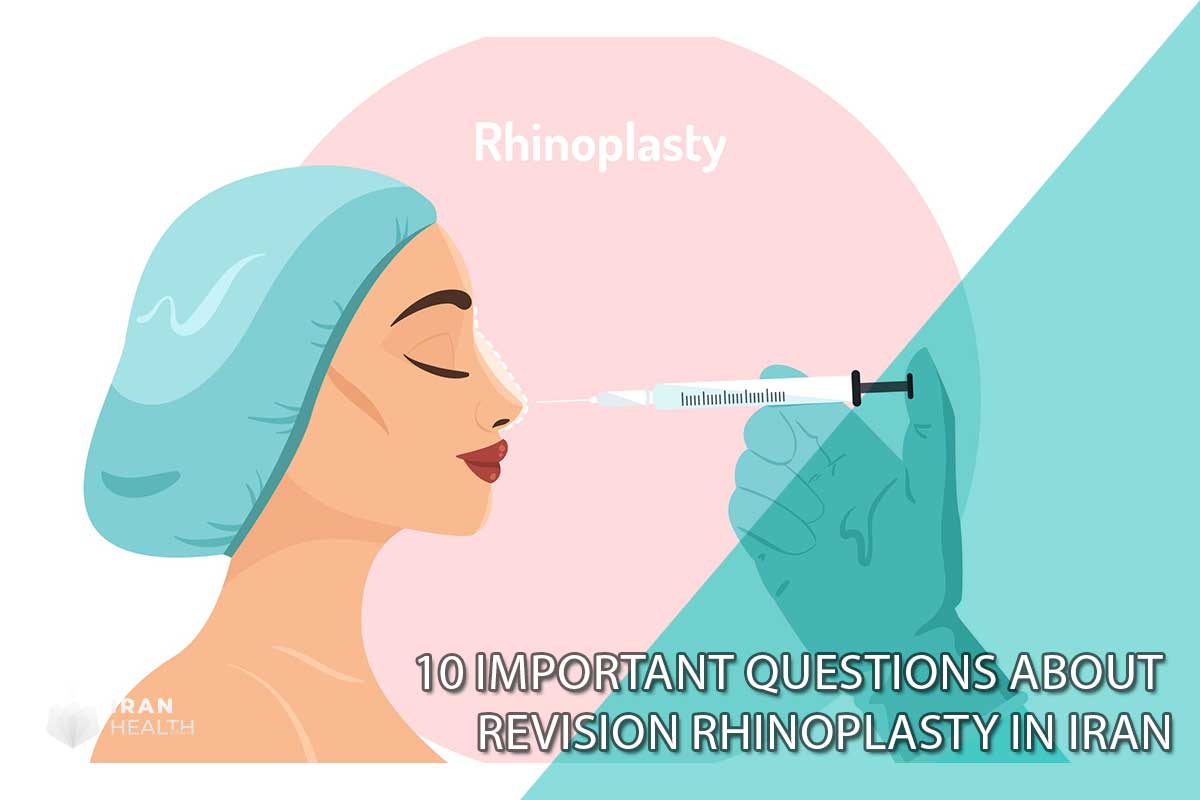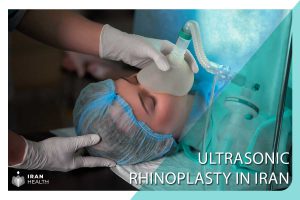Sometimes you may decide to have revision rhinoplasty for cosmetic reasons; For example, the result of your original rhinoplasty may be unnatural, or the shape of your nose may not be in harmony with the rest of your face after surgery.
Sometimes you might expect more changes than the result of surgery. In some patients, irregularities, deviations, bumps on the tip of the nose, scars, etc. may occur during the healing process.
Some patients also have to undergo revision surgery due to functional problems such as airway obstruction, nasal septal deviation, or any other reason. These patients may need functional nasal surgery, which includes septoplasty, nasal valve repair, or inferior turbinate reductions.
Whatever the reason for the revision rhinoplasty, it certainly raises a lot of questions in your mind. Here we share the answers to 10 important questions about revision nose surgery.

Does revision rhinoplasty take longer to heal?
Revision rhinoplasty is generally more complicated than the original rhinoplasty and will usually take longer for both surgery and recovery.
The reason for the greater complexity is simple! Changes in the nasal bone, and cartilage in the first surgery, in addition to the formation of excess scar tissue, place limitations on the surgeon in revision rhinoplasty. He or she needs to be more careful to make any changes.
For these reasons, your nasal tissues usually need more time to heal in revision nose surgery as well. The recovery period may take two years or more in patients whose nasal skin is thick and prone to scarring.
You may also like: Rhinoplasty in Iran and its Price
Can revision rhinoplasty be closed?
Short answer, yes. Approximately 30% of revision rhinoplasties are performed in a closed manner. The reason that reconstructive surgery is performed more with open technique is that it gives the surgeon more access to the tissues inside the nose.
Because most revision rhinoplasties are aimed at repairing damage to the tissues inside the nose, the surgeon prefers to use the open method. However, in some types of revision rhinoplasty, closed surgery will be possible.
The important thing is that both open and closed surgeries can bring great results, the choice of surgery depends on your nose condition and the skill of your surgeon in each of these techniques.
In general, each of these methods has advantages and disadvantages, and the surgeon will suggest you the best technique after the pre-op consultation.

When can you do revision rhinoplasty?
Most experienced plastic surgeons advise their patients to postpone revision rhinoplasty until the swelling is completely gone. Most of the swelling disappears from 6 months to a year after rhinoplasty.
Since the swelling of the nose after rhinoplasty may decrease at different rates in different areas of the nose, in addition to making the nose appear larger, this swelling may also cause its shape to be asymmetrical and disproportionate.
For example, the swelling in the tip of the nose usually disappears at a slower rate than the bridge of the nose, or on one side of the nose, you may have more swelling than the other side.
All of these may cause the patient to be dissatisfied with the outcome of the first operation, while many patients may change their minds after about a year.
Also, even if you definitely need revision rhinoplasty for other reasons, you may need to wait a while for the nasal tissues to heal.
Does revision rhinoplasty hurt?
The pain and discomfort after revision rhinoplasty will not be much different from your previous surgery. During surgery, you will be under general anesthesia and feel nothing. After the operation, your doctor will usually prescribe some painkillers to help you control the pain and discomfort after revision rhinoplasty.
After surgery, it is necessary to stay at home for 1 to 2 weeks to rest and recover. In this surgery, a splint is usually placed on your nose to protect your nose structure that is usually removed after a week. However, most revision rhinoplasties do not use intranasal packing.

Is revision rhinoplasty common?
The average rate of revision rhinoplasty will vary from country to country and from a surgeon to another.
Sometimes it is the surgery error that makes revision rhinoplasty necessary; Sometimes it is the race, skin thickness, and structure of the nose.
In general, according to statistics, the rate of revision rhinoplasty is about 1 to 10 percent. The need for reoperation in a country like Iran, which is known as the capital of rhinoplasty in the world, is very small due to surgeons’ experience and specialty.
Also, the success rate of revision rhinoplasties in Iran is very high because a large number of domestic and international patients undergo this surgery in Iran every year.
Do you have to pay for revision rhinoplasty?
Surgeons may have a different approach to the cost of revision rhinoplasty. Some of them reoperate their patients for free; Others perform revision rhinoplasty at a lower cost.
Some surgeons also do not receive a surgical fee but ask the patients to pay the rest of the costs, including the cost of the operating room and consumables materials such as anesthesia drugs.
Is revision rhinoplasty more expensive?
Because revision rhinoplasty is a more complex and longer surgery, it costs far more than initial rhinoplasty. The complexity of this surgery requires the high skill of the surgeon and the use of the latest surgical techniques and facilities.
Sometimes a cartilage graft may be needed, which is usually removed from the patient’s body before surgery. So it makes sense that this surgery would cost more. However, as mentioned in the answer to the previous question, if you have your revision surgery with your previous surgeon, you will probably pay less. Of course, you are unlikely to do so!
Is revision nose surgery good for bulbous nose?
Short answer, yes! One of the most common causes for patients undergoing revision rhinoplasty is the bulbous nose that is a nose with an enlarged or ill-defined tip. Swelling of the nose tip disappears later than other parts, however after a year, if you are still unsatisfied with the shape of your nose tip, revision surgery may be a suitable option for you.

Is it dangerous?
In general, it cannot be said that the risks of revision rhinoplasty are higher than the initial surgery. However, every surgery has its own possible risks and complications and revision rhinoplasty is no exception to this rule. The most common risks and complications of this surgery are temporary loss of smell, color change or bruising of the nasal skin, swelling, scars, respiratory problems, infection, etc. In general, revision surgery is a complex yet sensitive surgery, and you must look for the best and most experienced plastic surgeon for it.
Can I go to Iran for revision rhinoplasty?
Revision rhinoplasty in Iran is a smart choice. surgeons in plastic surgery in Iran, in addition to being board-certified and using the latest techniques and medical equipment, have extensive experience in a variety of plastic surgeries, especially rhinoplasty. You have probably heard that Iran is known as the capital of rhinoplasty in the world, which is due to the high demand and low cost of this surgery in Iran. That is why the level of satisfaction with the outcome of surgery by Iranian surgeons is higher than the global average. You can plan to perform this surgery in Iran through reputable medical tourism platforms such as Iran Health Agency.



